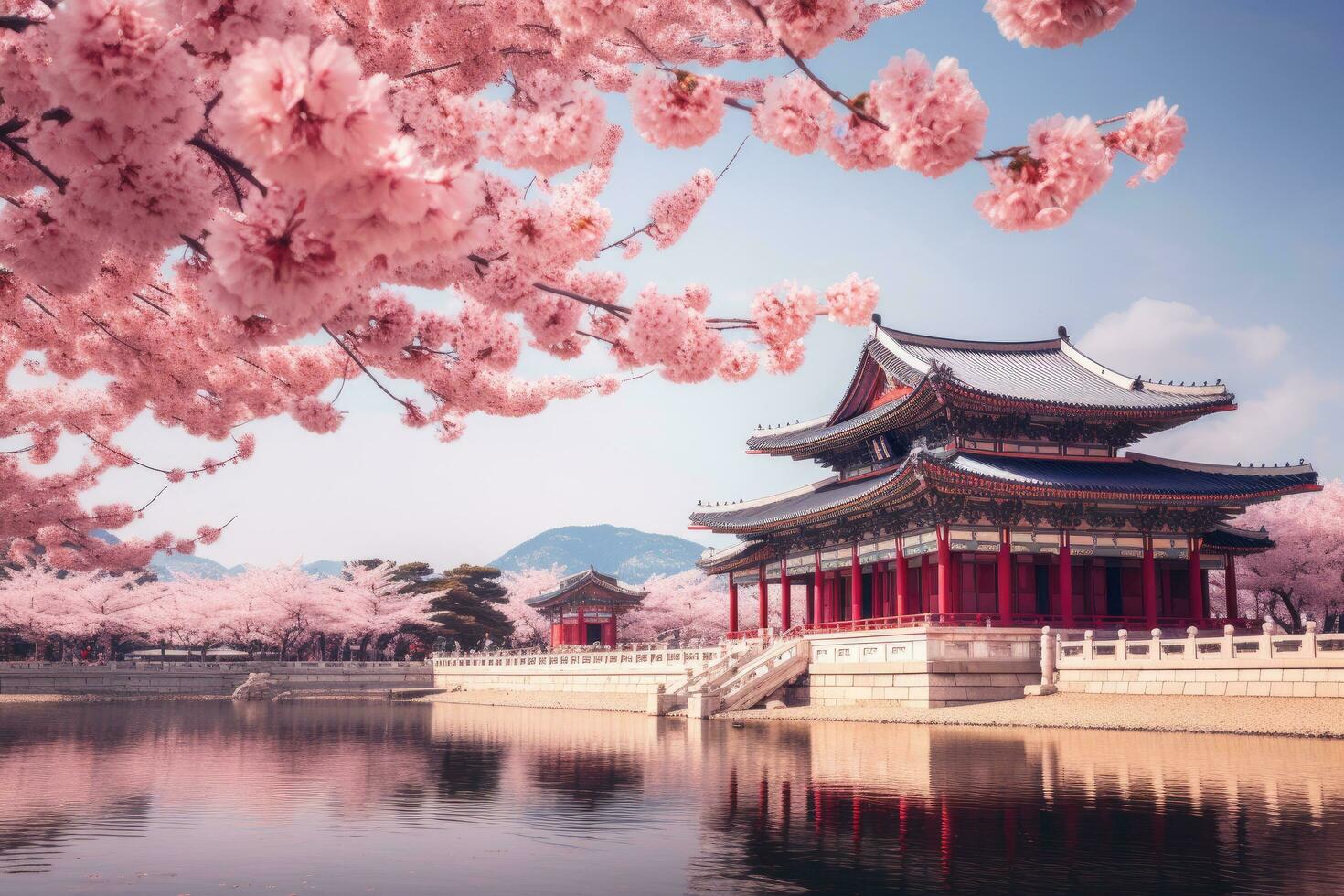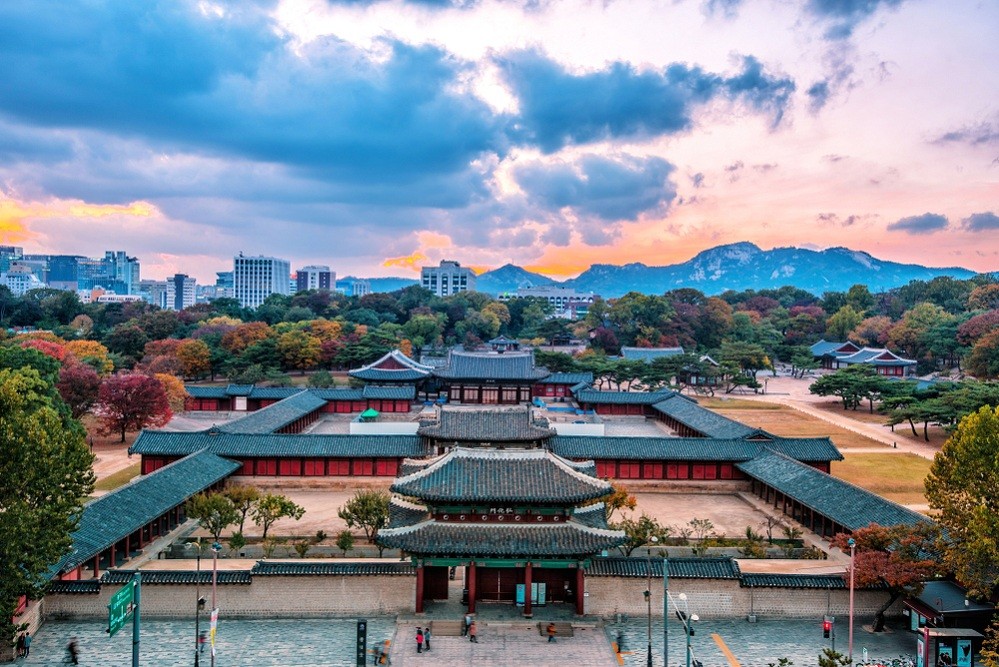The Palaces of Seoul are a testament to Korea’s rich history and culture. These magnificent structures serve as a window into the past, allowing visitors to explore and appreciate the grandeur of Korean royalty. From the majestic Gyeongbokgung Palace to the serene Gyeonghuigung Palace, each palace offers a unique experience that showcases the beauty and significance of Korean architecture and design. Exploring these palaces is not only a journey through time but also an opportunity to immerse oneself in the traditions and customs of Korea.
Gyeongbokgung Palace

Gyeongbokgung Palace, also known as the Palace of Shining Happiness, is Seoul’s largest and most iconic palace. Built in 1395, it was the main royal palace during the Joseon Dynasty. The castle was destroyed during the Japanese invasion in 1592 but was later restored in the 19th century. Today, it stands as a symbol of Korean heritage and resilience.
Within the palace grounds, there are several must-see attractions. The Geunjeongjeon Hall is the main throne hall where important ceremonies and events occur. Its grandeur is awe-inspiring, with its intricate architectural details and vibrant colors. Another highlight is the Gyeonghoeru Pavilion, a beautiful pavilion on an artificial island in a large pond. It was used for royal banquets and is surrounded by stunning views of nature.
Changdeokgung Palace
![Discovering the Majestic Palaces of Seoul: A Journey Through Korean Royalty 3 Changdeokgung Palace Complex [UNESCO World Heritage Site] (창덕궁과 후원 [유네스코 세계문화유산]) : VISITKOREA](https://tong.visitkorea.or.kr/cms/resource/84/2932684_image2_1.bmp)
Changdeokgung Palace is another significant palace in Seoul and has been designated as a UNESCO World Heritage Site. Built in 1405, it was the secondary royal palace during the Joseon Dynasty. What sets Changdeokgung Palace apart from other courts is its Secret Garden, also known as Huwon. This garden is a masterpiece of Korean landscape design, with its harmonious blend of natural elements and artificial structures.
The Secret Garden is a tranquil oasis within the palace grounds, featuring beautiful pavilions, ponds, and lush vegetation. It was a place where the royal family could relax and enjoy the beauty of nature. Visitors can take guided tours of the Secret Garden and explore its hidden corners, immersing themselves in the serenity and beauty of this hidden gem.
Deoksugung Palace

Deoksugung Palace is unique among Seoul’s palaces, combining traditional Korean architecture with Western influences. Built in the 15th century, it served as a residence for various royal family members. In the late 19th century, Western-style buildings were added to the palace complex, creating an interesting juxtaposition of architectural styles.
Highlights of Deoksugung Palace include the Junghwajeon Hall, used for important ceremonies and meetings, and the Seokjojeon Hall. This Western-style building served as a residence for King Gojong. The contrast between the traditional Korean buildings and the Western-style structures is fascinating to observe and provides insight into Korea’s history during a time of rapid modernization.
Changgyeonggung Palace

Changgyeonggung Palace has a long history dating back to the 12th century. It was a secondary palace during the Joseon Dynasty and was later converted into a park during the Japanese occupation. Today, it is a testament to Korea’s resilience and determination to preserve its cultural heritage.
What sets Changgyeonggung Palace apart from other palaces is its unique features. The castle is surrounded by beautiful gardens and ponds, creating a peaceful and serene atmosphere. It also houses the National Palace Museum of Korea, where visitors can learn more about Korean history and culture through various artifacts and exhibits.
Gyeonghuigung Palace

Tourists often overlook Gyeonghuigung Palace, but it offers a peaceful and serene atmosphere perfect for those seeking a quieter experience. Built in the 17th century, it served as a secondary palace and was later used as a military headquarters during Japanese occupation.
Attractions within the palace grounds include the Geumcheongyo Bridge, adorned with beautiful lotus flower patterns, and the Jeonggwanheon Pavilion, where the royal family would relax and enjoy the beauty of nature. The palace also offers guided tours and cultural programs, allowing visitors to learn more about Korean history and traditions.
Uncovering the Hidden Gems of Seoul’s Palaces
While Gyeongbokgung, Changdeokgung, Deoksugung, Changgyeonggung, and Gyeonghuigung are the most well-known palaces in Seoul, several lesser-known palaces are worth exploring. These hidden gems offer a unique perspective on Korean history and culture.
One such palace is Changgyeonggung Palace, which was built in the 15th century and served as a secondary palace during the Joseon Dynasty. It is known for its beautiful gardens and ponds, which provide a peaceful and serene atmosphere. Another hidden gem is Unhyeongung Palace, built in the 19th century and served as a residence for Prince Regent Daewon-gun. It offers a glimpse into the life of Korean royalty during this period.
The Royal Guard Changing Ceremony
One of the highlights of visiting the palaces of Seoul is witnessing the Royal Guard Changing Ceremony. This traditional ceremony occurs at Gyeongbokgung Palace and offers a glimpse into Korea’s royal past.
The ceremony reenacts the changing of the guards who protected the palace during the Joseon Dynasty. The guards, dressed in colorful traditional uniforms, march in perfect synchronization to the beat of traditional music. It is a spectacle that should not be missed and provides a unique opportunity to experience Korean culture and tradition.
The Significance of Traditional Korean Architecture in the Palaces of Seoul
Traditional Korean architecture plays a significant role in the design and construction of the palaces of Seoul. It is characterized by its emphasis on harmony with nature, simplicity, and balance.
One of the key features of traditional Korean architecture is the use of wooden structures and curved roofs. These curved roofs, known as “giwa,” are designed to mimic the shape of a bird’s wings and are believed to bring good luck and protection. Another important element is the use of vibrant colors and intricate patterns, often seen in the decorative details of the palaces.
The Legacy of Korean Royalty
The palaces of Seoul are not just historical landmarks but also testaments to the legacy of Korean royalty. They remind us of Korea’s rich history and cultural heritage.
Preserving these palaces is crucial for future generations to understand and appreciate Korea’s past. They link to Korea’s royal history and contribute to its cultural identity. By exploring these palaces, visitors can gain a deeper understanding of Korean culture and traditions and develop a greater appreciation for the beauty and significance of these architectural wonders.
Exploring the Palaces of Seoul is an opportunity to immerse oneself in Korea’s rich history and culture. From the grandeur of Gyeongbokgung Palace to the tranquility of Gyeonghuigung Palace, each palace offers a unique experience that showcases the beauty and significance of Korean architecture and design. Visiting these palaces can better understand Korea’s past and develop a greater appreciation for its cultural heritage. So, why not plan a trip to Seoul and experience the beauty and history of these magnificent palaces for yourself?











